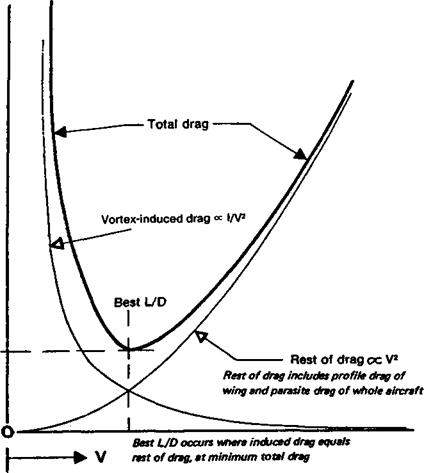VORTEX DRAG
In Figures 2.8-10 Де types of drag are illustrated. Induced drag is now called vortex drag because it is associated whh the rotating vortices which trail behind any wing, or any surface, which is yielding aerodynamic lift The appearance of Де vortices is directly associated wiffi the lift Де higher Де lift coefficient of a given wing. Де more significant is Де effect of Де vortices. Since when flight speed, V, is low, a given model must work at a higher lift coefficient Дап when V is high, Де induced drag increases as the velocity decreases. (Maffiematically, vortex-induced drag is proportional to L/V2.) This is the major, though not Де only cause of Де reduction of L/D at low speeds mentioned above.
Fig. 2.10 Skin friction or viscous drag
smooth wave-free skin _
Low drag surface
|
|
High drag, surface
2.IS PROFILE DRAG
Form or pressure drag is caused by the total of all the pressure variations over a body as the air flows round it, and skin friction or viscous drag is caused by the contact of the air with the model’s surfaces. Although it is useful to separate these different types of drag for purposes of study, it is clear that they almost always occur together. For instance, the wings shown in Figure 2.8 will produce both form drag and skin friction in addition to vortex drag. The body whose skin is sketched in Fig. 2.10 will probably be part of wing or fuselage which has form drag also. The relationship between skin drag and form drag is particularly close: the two affect one another. For example, skin friction is very much governed by the speed of the air flow, and the speed of the local flow next to the skin is
|
Fig. 2.11 The composition of the total drag of an aircraft
|
mainly determined by the shape of the body as a whole. (See Bernoulli’s theorem, Chapter 3.) For this reason, particularly when wings are concerned, skin friction and form drag are commonly taken together and termed profile drag. In contrast to induced drag, skin friction and form drag are both directly proportional to V2. Thus, as the induced drag falls with rising speed, the form drag and skin drag rise, and vice versa. The result, in graphical form, is shown in Figure 2.11.














